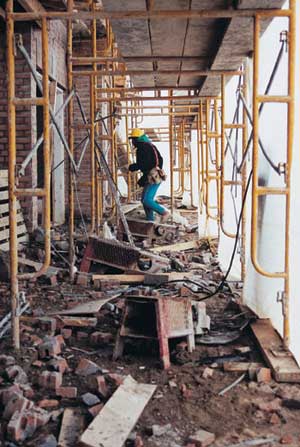Summary Statement
Short article on the need for good housekeeping and the suggestion that contracts should spell out responsibilities, as should managers.
WInter 2001/2002
 The
homebuilding project in the photo is a mess. But who's supposed to clean
it up?
The
homebuilding project in the photo is a mess. But who's supposed to clean
it up?
Waste accumulates fast on site--scrap lumber, broken bricks, packaging, pieces of drywall, garbage from coffee breaks and lunches. Construction rubbish tends to be irregular in shape, hard to handle, and full of sharp objects.
Too often site
upkeep is not considered part of the job. In defining responsibilities,
contractors seldom discuss housekeeping details. As a result, each trade
expects the other to clean up.
Tender documents should spell out housekeeping responsibilities. Contracts
should specify, for instance, who is to provide disposal bins and arrange
disposal. Putting garbage in containers is not enough. The containers
must be emptied. Access and storage areas should also be planned out
and designated.
Bad housekeeping
is dangerous at any time. It can be directly linked to one out of four
injuries in construction. It leads to increased risks, production delays,
property damage, and higher costs. In winter it poses a fire hazard
when work areas are closed in and gas heaters are running.
For more information, buy or borrow CSAO's videotape Whose Job Is It Anyway?
Contact Customer Service at 1-800-781-2726.


